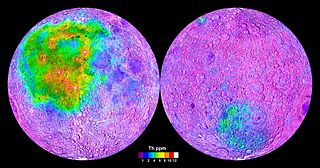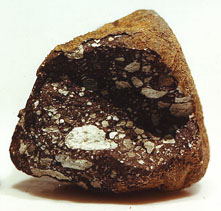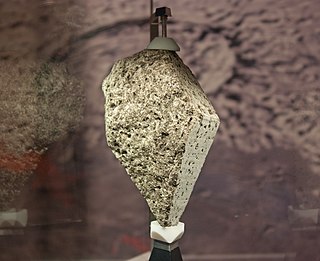Related Research Articles

KREEP, an acronym built from the letters K, REE and P, is a geochemical component of some lunar impact breccia and basaltic rocks. Its most significant feature is somewhat enhanced concentration of a majority of so-called "incompatible" elements and the heat-producing elements, namely radioactive uranium, thorium, and potassium.

A lunar meteorite is a meteorite that is known to have originated on the Moon. A meteorite hitting the Moon is normally classified as a transient lunar phenomenon.

Impactite is rock created or modified by one or more impacts of a meteorite. Impactites are considered metamorphic rock, because their source materials were modified by the heat and pressure of the impact. On Earth, impactites consist primarily of modified terrestrial material, sometimes with pieces of the original meteorite.

Sayh al Uhaymir 169 is a 206 gram lunar meteorite found in the Sayh al Uhaymir region of the Sultanate of Oman in January 2002.

The geology of the Moon is quite different from that of Earth. The Moon lacks a true atmosphere, and the absence of free oxygen and water eliminates erosion due to weather. Instead, the surface is eroded much more slowly through the bombardment of the lunar surface by micrometeorites. It does not have any known form of plate tectonics, it has a lower gravity, and because of its small size, it cooled faster. In addition to impacts, the geomorphology of the lunar surface has been shaped by volcanism, which is now thought to have ended less than 50 million years ago. The Moon is a differentiated body, with a crust, mantle, and core.

Moon rock or lunar rock is rock originating from Earth's Moon. This includes lunar material collected during the course of human exploration of the Moon, and rock that has been ejected naturally from the Moon's surface and landed on Earth as meteorites.

Dante S. Lauretta is a professor of planetary science and cosmochemistry at the University of Arizona's Lunar and Planetary Laboratory. He is the principal investigator on NASA's OSIRIS-REx mission.

Lunar regolith is the unconsolidated material found on the surface of the Moon and in the Moon's tenuous atmosphere. Sometimes referred to as Lunar soil, Lunar soil specifically refers to the component of regolith smaller than 1 cm. It differs substantially in properties from terrestrial soil.

The Lunar Magma Ocean (LMO) is the layer of molten rock that is theorized to have been present on the surface of the Moon. The Lunar Magma Ocean was likely present on the Moon from the time of the Moon's formation to tens or hundreds of millions of years after that time. It is a thermodynamic consequence of the Moon's relatively rapid formation in the aftermath of a giant impact between the proto-Earth and another planetary body. As the Moon accreted from the debris from the giant impact, gravitational potential energy was converted to thermal energy. Due to the rapid accretion of the Moon, thermal energy was trapped since it did not have sufficient time to thermally radiate away energy through the lunar surface. The subsequent thermochemical evolution of the Lunar Magma Ocean explains the Moon's largely anorthositic crust, europium anomaly, and KREEP material.

An impact structure is a generally circular or craterlike geologic structure of deformed bedrock or sediment produced by impact on a planetary surface, whatever the stage of erosion of the structure. In contrast, an impact crater is the surface expression of an impact structure. In many cases, on Earth, the impact crater has been destroyed by erosion, leaving only the deformed rock or sediment of the impact structure behind. This is the fate of almost all old impact craters on Earth, unlike the ancient pristine craters preserved on the Moon and other geologically inactive rocky bodies with old surfaces in the Solar System. Impact structure is synonymous with the less commonly used term astrobleme meaning "star wound".

David Stewart McKay was chief scientist for astrobiology at the Johnson Space Center. During the Apollo program, McKay provided geology training to the first men to walk on the Moon in the late 1960s. McKay was the first author of a scientific paper postulating past life on Mars on the basis of evidence in Martian meteorite ALH 84001, which had been found in Antarctica. This paper has become one of the most heavily cited papers in planetary science. The NASA Astrobiology Institute was founded partially as a result of community interest in this paper and related topics. He was a native of Titusville, Pennsylvania.

Traces of Catastrophe: A Handbook of Shock-Metamorphic Effects in Terrestrial Meteorite Impact Structures is a book written by Bevan M. French of the Smithsonian Institution. It is a comprehensive technical reference on the science of impact craters. It was published in 1998 by the Lunar and Planetary Institute (LPI), which is part of the Universities Space Research Association (USRA). It was originally available in hard copy from LPI, but is now only available as a portable document format (PDF) e-book free download.

Planetary science is the scientific study of planets, celestial bodies and planetary systems and the processes of their formation. It studies objects ranging in size from micrometeoroids to gas giants, aiming to determine their composition, dynamics, formation, interrelations and history. It is a strongly interdisciplinary field, which originally grew from astronomy and Earth science, and now incorporates many disciplines, including planetary geology, cosmochemistry, atmospheric science, physics, oceanography, hydrology, theoretical planetary science, glaciology, and exoplanetology. Allied disciplines include space physics, when concerned with the effects of the Sun on the bodies of the Solar System, and astrobiology.
This is a glossary of terms used in meteoritics, the science of meteorites.

Allan Hills A81005 or ALH A81005 was the first meteorite to be recognised as a lunar meteorite. The meteorite Yamato 791197 was discovered in 1979 but its lunar origin was not recognised until 1984. ALH A81005 was found in 1982 in the Allan Hills at the end of the Transantarctic Mountains, during a meteorite gathering expedition (ANSMET).

Ursula Bailey Marvin was an American planetary geologist and author who worked for the Smithsonian Astrophysical Observatory.

Lunar Sample 14321, better known as "Big Bertha", is a lunar sample containing an embedded Earth-origin meteorite collected on the 1971 Apollo 14 mission. It was found in the Fra Mauro region of the Moon. Big Bertha is the first discovered meteorite from Earth, and the embedded meteorite portion is the oldest known Earth rock. At 8.998 kg (19.84 lb), this breccia rock is the third largest Moon sample returned during the Apollo program, behind Big Muley and Great Scott.
Ghislaine Crozaz is a cosmochemist known for her research on the early history of the solar system through tracking trace elements in meteorites.

Yoshiokaite, a mineral formed as shocked crystal fragments in devitrified glass, was discovered in lunar regolith breccia collected from a trench by the Apollo 14 crew in 1971. Although there have been other minerals that have been originally discovered on the Moon, yoshiokaite is the first new mineral with origin related to lunar highlands. Yoshiokaite is considered to be a member of the feldspathoid group.
References
- 1 2 3 4 5 Meteoritical Bulletin Database: Yamato 791197
- ↑ Cassidy, William A. (2003). Meteorites, Ice, and Antarctica. Cambridge University Press. p. 186.
- ↑ Korotev, Randy L. "Lunar Meteorite: Yamato 791197". Washington University in St. Louis, Department of Earth and Planetary Sciences. Retrieved 2011-11-15.
- ↑ "Lunar Meteorite: Yamato 791197 | Some Meteorite Information | Washington University in St. Louis". sites.wustl.edu. Retrieved 2024-08-04.
- ↑ Ostertag, R.; et al. (1985). "Lunar meteorite Yamato 791197: a weakly shocked regolith breccia from the far side of the Moon". Lunar and Planetary Science. XVI/3: 635–636. Bibcode:1985LPI....16..635O.